
Albrecht Altdorfer was a German painter, engraver and architect of the Renaissance working in Regensburg, Bavaria. Along with Lucas Cranach the Elder and Wolf Huber he is regarded to be the main representative of the Danube School, setting biblical and historical subjects against landscape backgrounds of expressive colours. He is remarkable as one of the first artists to take an interest in landscape as an independent subject. As an artist also making small intricate engravings he is seen to belong to the Nuremberg Little Masters.

The siege or battle of Pavia was fought in 773–774 in northern Italy, near Ticinum, and resulted in the victory of the Franks under Charlemagne against the Lombards under King Desiderius.
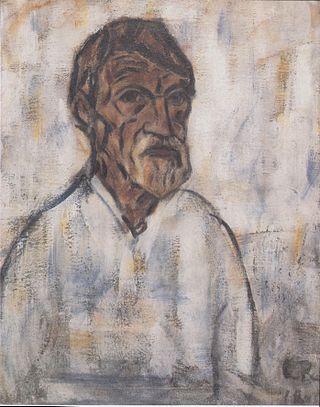
Christian Rohlfs was a German painter and printmaker, one of the important representatives of German expressionism.
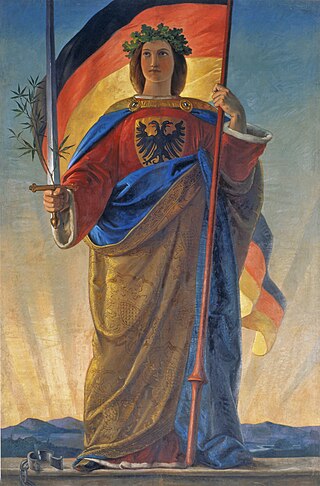
Germania is the name of a painting that was probably created in March 1848. It hung in the St. Paul's Church (Paulskirche) in Frankfurt, Germany. At that time, first the so-called Pre-Parliament and then the Frankfurt National Assembly, the first all-German parliament, met there. The National Assembly was a popular motif of the time, so the Germania painting also became very well-known. After the National Assembly was violently terminated in May 1849, the painting was taken down. In 1867 it was moved to the German National Museum in Nuremberg.

The Battle of Frankenhausen was fought on 14 and 15 May 1525. It was an important battle in the German Peasants' War and the final act of the war in Thuringia: joint troops of Landgrave Philip I of Hesse and Duke George of Saxony defeated the peasants under their spiritual leader Thomas Müntzer near Frankenhausen in the County of Schwarzburg.

The Council of Frankfurt, traditionally also the Council of Frankfort, in 794 was called by Charlemagne, as a meeting of the important churchmen of the Frankish realm. Bishops and priests from Francia, Aquitaine, Italy, and Provence gathered in Franconofurd. The synod, held in June 794, allowed the discussion and resolution of many central religious and political questions.

Wilhelm Lindenschmit (the Elder) (March 9, 1806 – March 12, 1848) was a German history painter born in Mainz. He was an older brother to prehistorian Ludwig Lindenschmit (1809–1893), and father to history painter Wilhelm Lindenschmit the Younger (1829–1895).
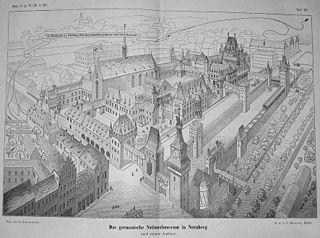
Nuremberg Charterhouse was a Carthusian monastery, or charterhouse, in Nuremberg in Germany. Its surviving premises are now incorporated into the Germanisches Nationalmuseum.

The so-called Sabre of Charlemagne is an early sabre of Hungarian (Magyar) type which has been exceptionally preserved as part of the Aachen regalia of the Holy Roman Empire. Along with the rest of the imperial regalia from both Aachen and Nuremberg, it is now kept in the Hofburg Palace, Vienna.

Georg Lemberger was a German painter and woodcut artist.

A Carolingian-era equestrian statuette in bronze depicting either Charlemagne or his grandson Charles the Bald, a rare example of surviving Carolingian sculpture in metal, is exhibited in the Louvre Museum. In the 16th, 17th and 18th centuries it was kept in Metz Cathedral.
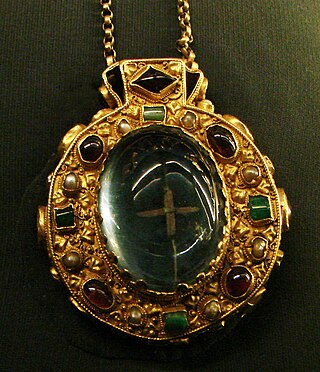
The Talisman of Charlemagne is a 9th-century Carolingian reliquary encolpion that may once have belonged to Charlemagne and is purported to contain a fragment of the True Cross. It is the only surviving piece of goldwork which can be connected with Charlemagne himself with some degree of probability, but the connection has been seriously questioned. The talisman is now kept in Rheims in the Palace of Tau.

Ernst Friedrich Theodor Lindner was a German historian.

Frederick the Great Playing the Flute at Sanssouci or The Flute Concert is an 1852 oil on canvas history painting by the German painter Adolph Menzel. It depicts Frederick the Great, King of Prussia playing the flute at an evening concert at Sanssouci and is now in the Alte Nationalgalerie in Berlin.
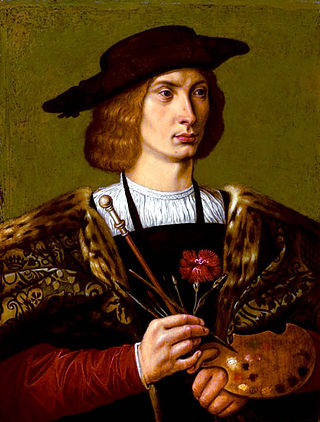
Michael Ostendorfer was a German painter, graphic artist and xylographer. Stylistically, he belongs to the Danube school and probably trained with Albrecht Altdorfer.
Georg Ulrich Großmann is a German art historian. He was general director of the Germanisches Nationalmuseum in Nuremberg.

Daniel Preissler was a German painter, originating from Bohemia.

Otto I, also called Otto the Great, is seen by many as one of the greatest medieval rulers. His name is usually associated with the foundation, the victory in the Battle of Lechfeld gained him, according to historian Jim Bradburn, a reputation as the great champion of Christendom, and the Ottonian Renaissance. Although historians in different eras have never denied his reputation as a successful ruler, the image of the nationalist political strongman which was usually perceived during the nineteenth century has been questioned by more recent sources. Modern historians explore the emperor's capability as a consensus builder, as well as the participation of princes in contemporary politics and the important roles played by female actors and his advisors in his endeavors. Mentioned also is that Otto did have a strong character. In many cases, Otto chose his own way, which also led to rebellions. He often emerged victorious in the end.
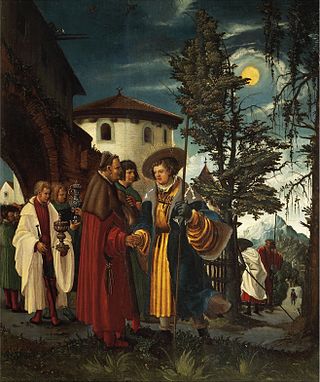
Saint Florian Taking Leave of the Monastery is an oil-on-panel painting by German artist Albrecht Altdorfer, dating from around 1518–1520. It is held in the Uffizi Gallery, in Florence.

The Martyrdom of Saint Florian is an oil-on-panel painting executed c.1518–1520 by the German artist Albrecht Altdorfer, signed with his "A in A" monogram on a post of the bridge on the right. It and the artist's Saint Florian Taking Leave of the Monastery were in the Spannocchi collection of the Pinacoteca nazionale di Siena until 1914, when they were both transferred to their present home in the Uffizi in Florence to strengthen the latter's holdings on the Northern Renaissance.



















